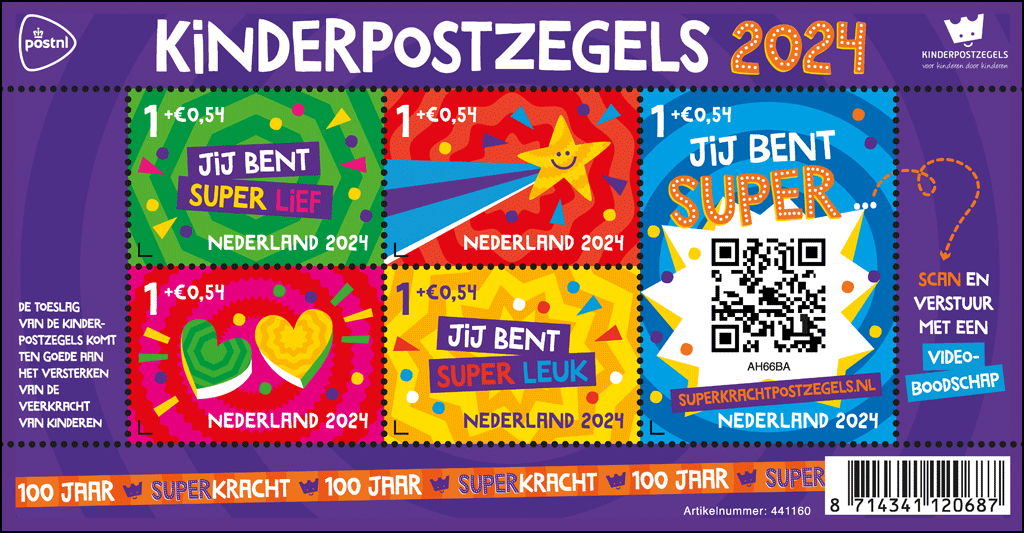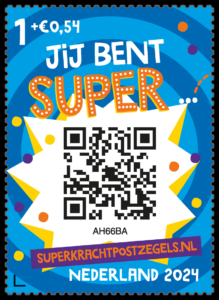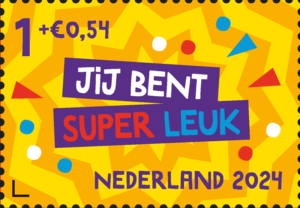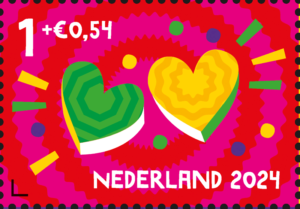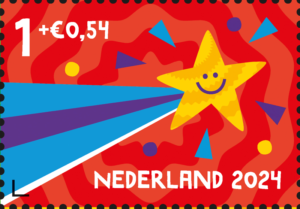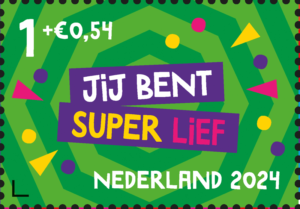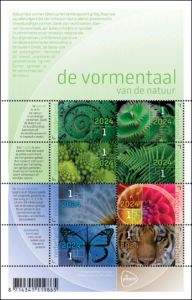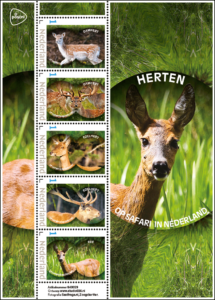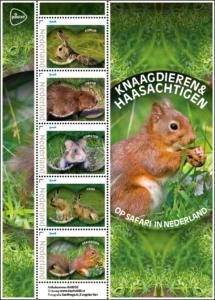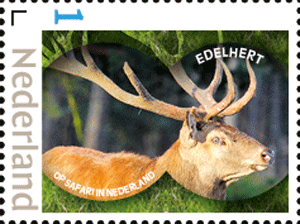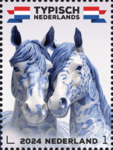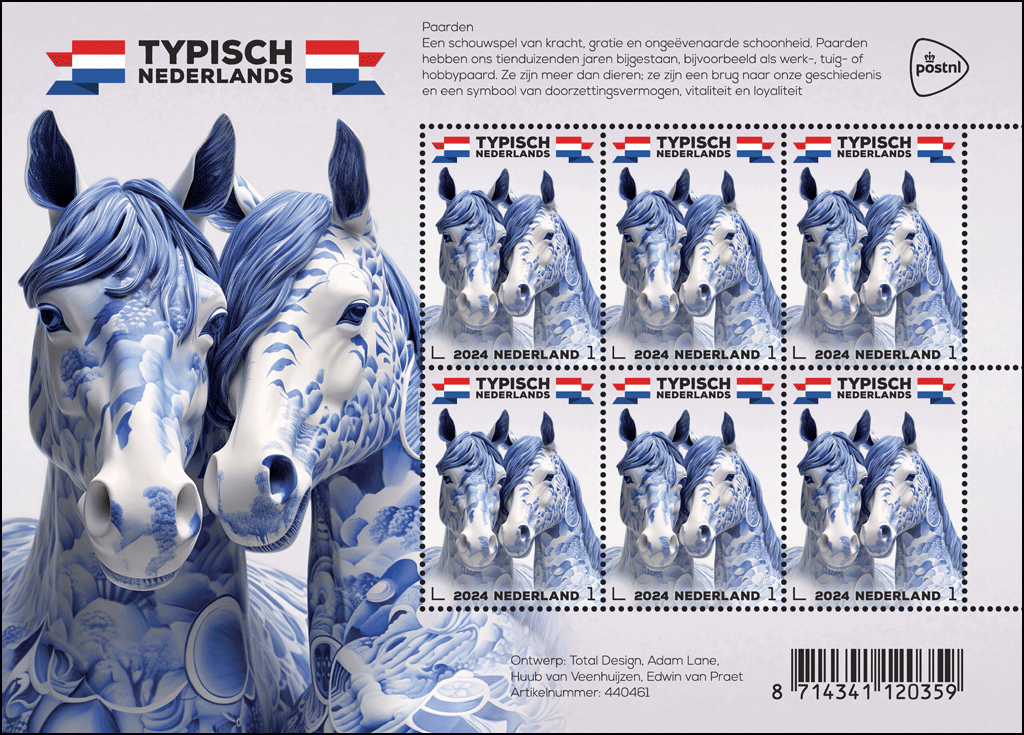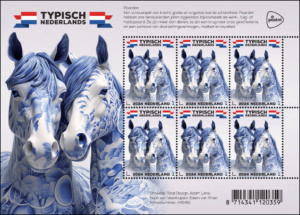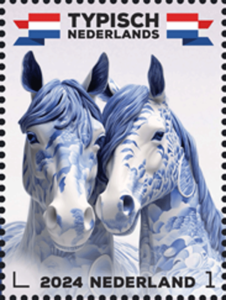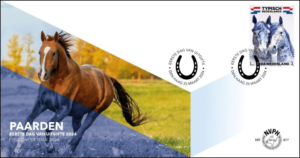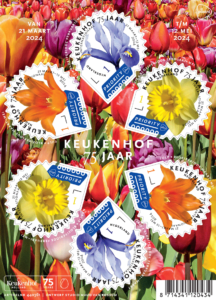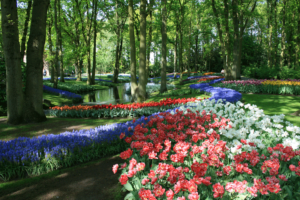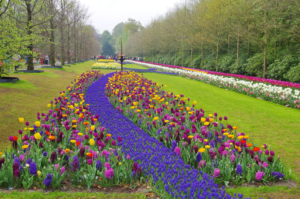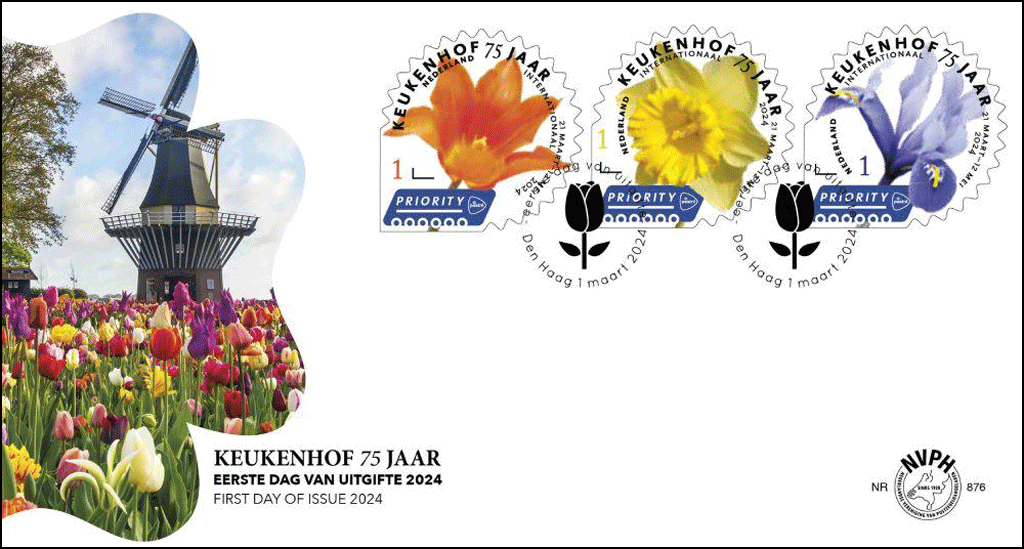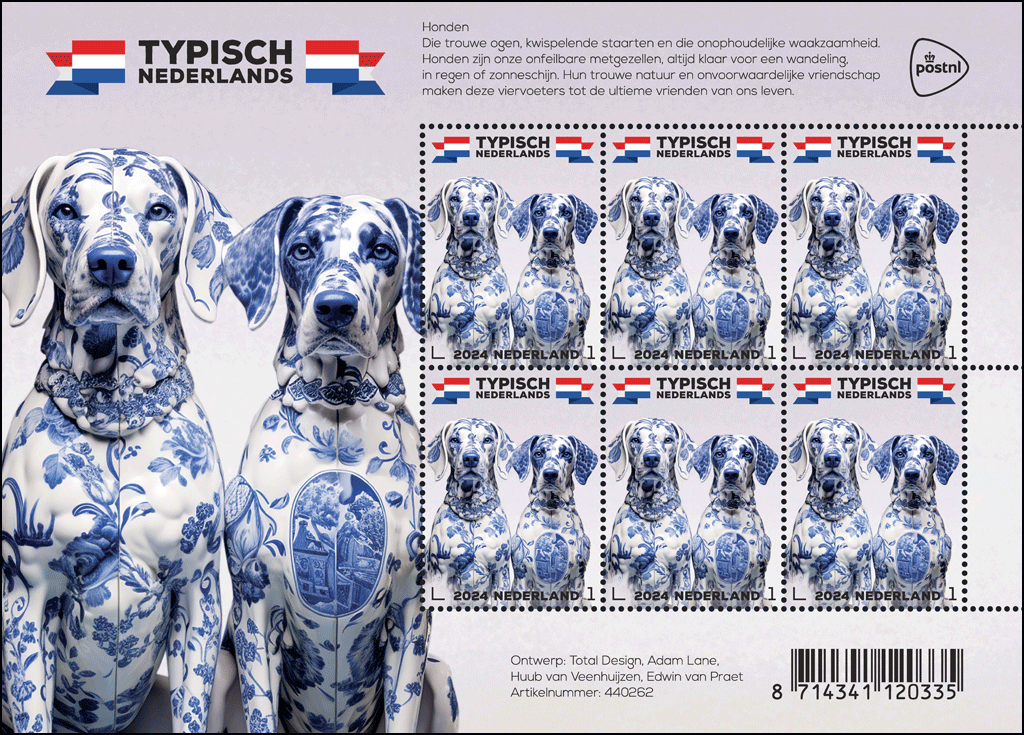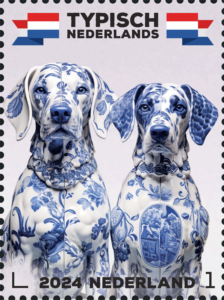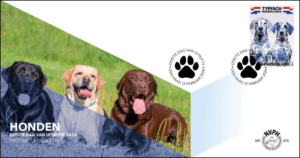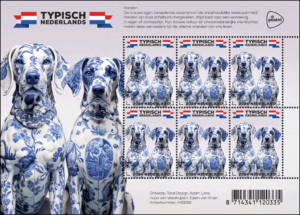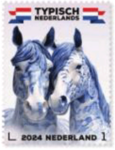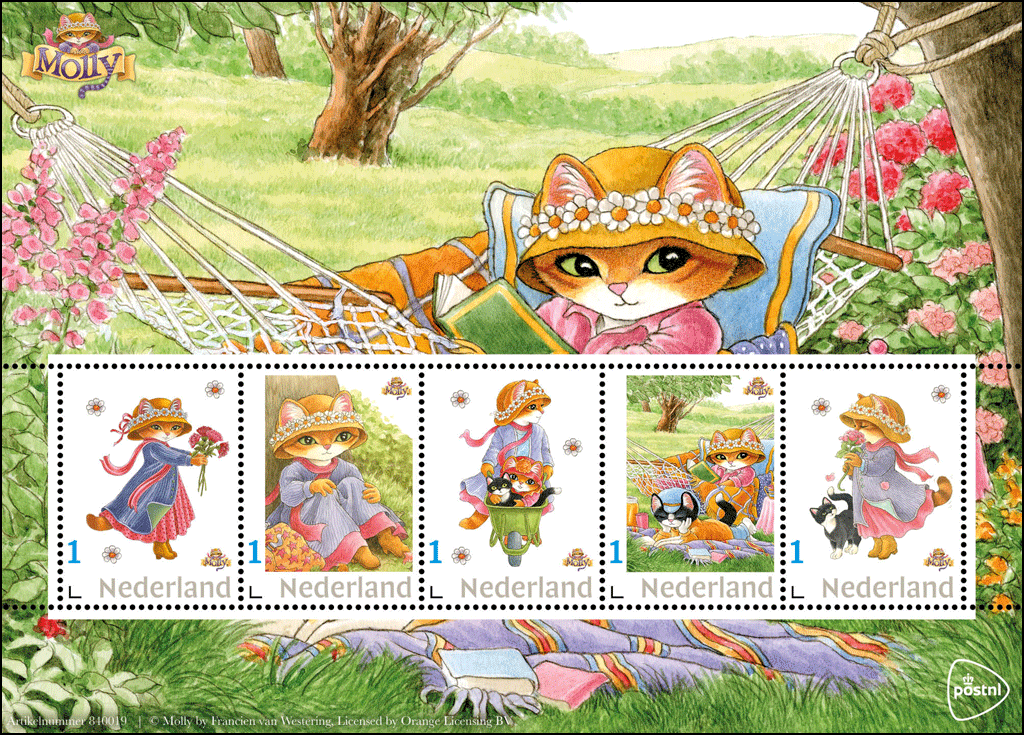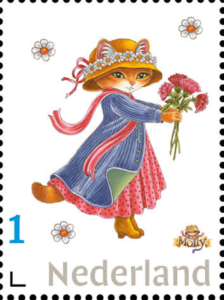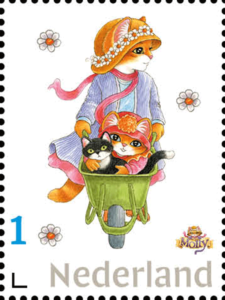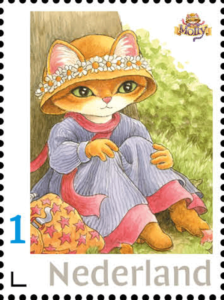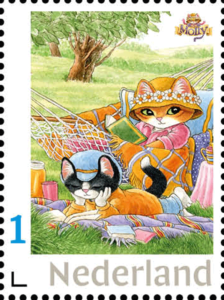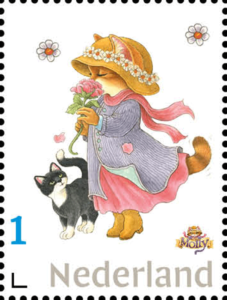[from PostNL press material] [click on any of the pictures for larger versions]
Experience Nature – Butterflies on Bonaire
Issue date: 12 February 2024
Appearance: sheet of ten stamps in ten different designs, with denomination ‘1’ for post weighing up to 20g with destinations in the Netherlands
Item number: 440261
Design: Frank Janse, Gouda
Photography: Alamy, Dreamstime, Shutterstock and Wikimedia Commons (Anne Toal, Charles J. Sharp, Gailhampshire, Renee from Las Vegas, Vinayaraj)
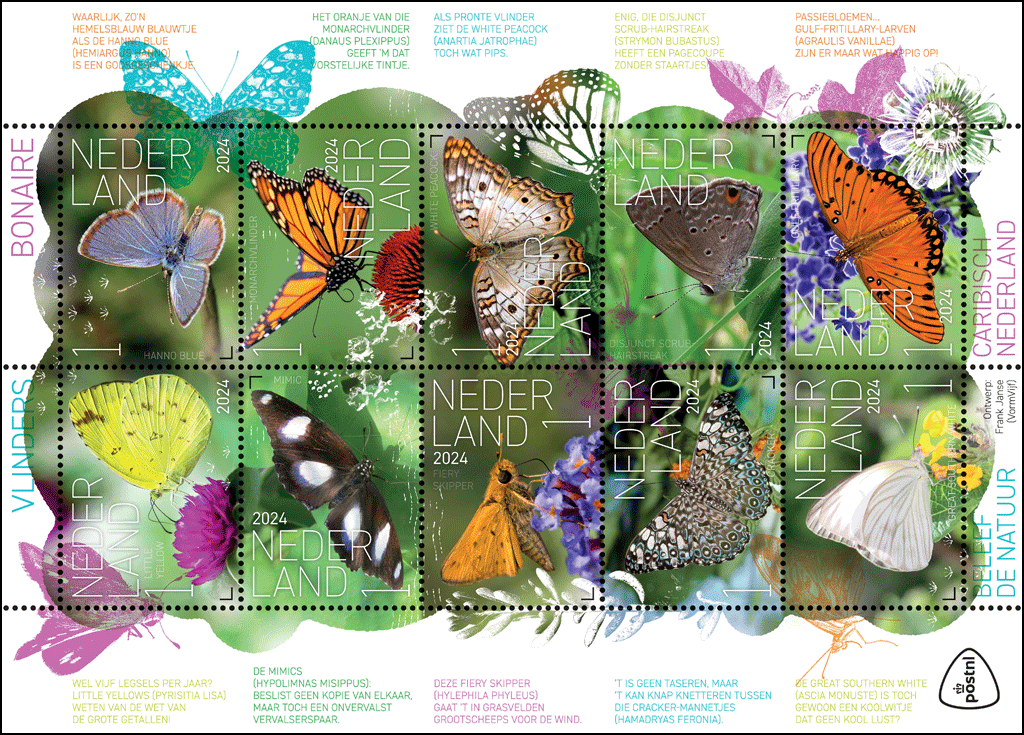 This is a sheet of ten stamps in ten different designs. The stamps carry bear denomination ‘1’ for post weighing up to 20g with destinations in the Netherlands, and a sheet of ten
This is a sheet of ten stamps in ten different designs. The stamps carry bear denomination ‘1’ for post weighing up to 20g with destinations in the Netherlands, and a sheet of ten 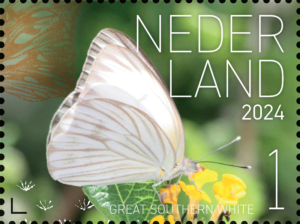 stamps costs €10.90 [currently about US$11.75]. It is part of the multi-year Experience Nature series dedicated to the Caribbean Netherlands from 2024 to 2026. As part of this series, four stamp sheets will be released every year, each containing ten different stamps. The stamps feature plants and animals found in this part of the Netherlands. With thousands of species of plants and animals, the islands in this area have a biodiversity unprecedented by Dutch standards. In 2024, the sheets in this series will focus on the birds, butterflies, underwater life and, lastly, flora found on the island of Bonaire.
stamps costs €10.90 [currently about US$11.75]. It is part of the multi-year Experience Nature series dedicated to the Caribbean Netherlands from 2024 to 2026. As part of this series, four stamp sheets will be released every year, each containing ten different stamps. The stamps feature plants and animals found in this part of the Netherlands. With thousands of species of plants and animals, the islands in this area have a biodiversity unprecedented by Dutch standards. In 2024, the sheets in this series will focus on the birds, butterflies, underwater life and, lastly, flora found on the island of Bonaire.
Experience Nature – Butterflies on Bonaire features the
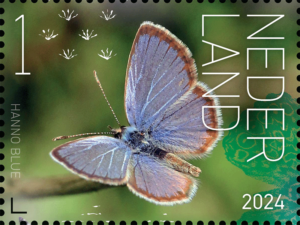 little yellow
little yellow- hanno blue
- mimic
- monarch
- fiery skipper
- white peacock
- cracker
- disjunct scrub-hairstreak
- great southern white and
- gulf fritillary butterflies.
Like Sint Eustatius and Saba, the island of Bonaire has a special status within the Netherlands. The collective name for the three islands is the Caribbean Netherlands. Along with the countries of Aruba, Curaçao and Sint Maarten, they form the Caribbean part of the Kingdom of the Netherlands. 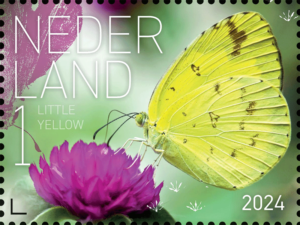 Bonaire comprises almost 29,000 hectares of land [about 112,000 square miles]. Bonaire is home to around 24,000 people, most of whom speak Papiamentu as their first language. The main sources of income are tourism and salt extraction, and the island is a popular destination for diving holidays and cruise ships. Much of the island has been designated as nature parks.
Bonaire comprises almost 29,000 hectares of land [about 112,000 square miles]. Bonaire is home to around 24,000 people, most of whom speak Papiamentu as their first language. The main sources of income are tourism and salt extraction, and the island is a popular destination for diving holidays and cruise ships. Much of the island has been designated as nature parks.
Of all the butterfly species in the world, around 265 are found on the Caribbean Netherlands, a significant proportion of which can be found on Bonaire. Their size varies widely. For example, the hawkmoth has a wingspan measuring up to 15cm, while the 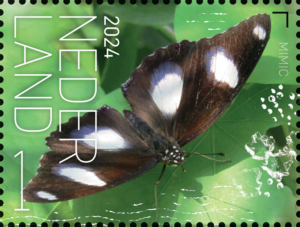 smallest lycaedinae do not grow beyond 2cm. The wingspan also depends on the time of year and the butterfly’s growth habit as a caterpillar.
smallest lycaedinae do not grow beyond 2cm. The wingspan also depends on the time of year and the butterfly’s growth habit as a caterpillar.
Many diurnal butterflies stand out for their variegated colours. The vast majority of butterflies are seen as useful, harmless animals because they are pollinators that are unable to sting and bite.
The Experience Nature – Butterflies on Bonaire stamp sheet was designed by Gouda-based graphic designer Frank Janse. All of the butterflies are featured in their natural 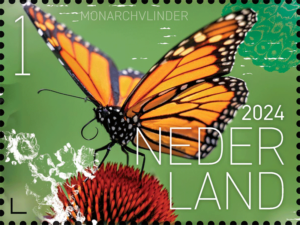 habitat on their own stamp. In several places on the stamp sheet, the designer has added graphics from symbols on old topographical maps. These symbols indicate landscape forms, contour lines, plantings, soil structures and watercourses, for example.
habitat on their own stamp. In several places on the stamp sheet, the designer has added graphics from symbols on old topographical maps. These symbols indicate landscape forms, contour lines, plantings, soil structures and watercourses, for example.
The design also features an additional transparent layer with monochrome images (both white and in colour) of typical flora and fauna from this area. The monochrome images are rendered almost 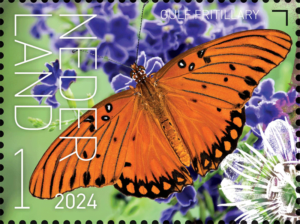 abstractly, running across the perforations and connecting the stamps with each other and the sheet edge. The following butterflies and plants are featured:
abstractly, running across the perforations and connecting the stamps with each other and the sheet edge. The following butterflies and plants are featured:
- the fiery skipper (top left)
- cracker (top right)
- a flowering cordia alba and underneath it a peacock flower (centre)
- the succulent krapéwiwiri plant (centre left)
- passionflower butterfly (bottom left) and
- the passion flower’s leaves and flower (bottom right).
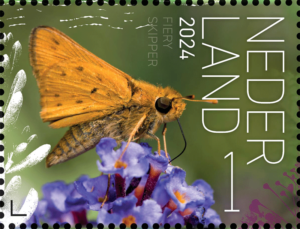 Butterflies are a favourite stamp subject for many postal organisations across the world. Janse thinks that’s understandable. “Butterflies always do well on stamps,” he said. “Not just because they’re attractive and colourful – their shape also fits nicely into the stamp format, and especially when they’re photographed from above.”
Butterflies are a favourite stamp subject for many postal organisations across the world. Janse thinks that’s understandable. “Butterflies always do well on stamps,” he said. “Not just because they’re attractive and colourful – their shape also fits nicely into the stamp format, and especially when they’re photographed from above.”
The stamp designer feels that is the best “pose” for butterflies, because it shows the markings of the wings. “You should always feature butterflies in their entirety – zooming in on just one section doesn’t work,” 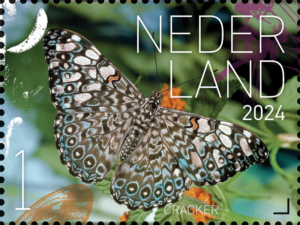 said Janse. “That’s why I made sure that all the butterflies on the stamps were kept within the frames.”
said Janse. “That’s why I made sure that all the butterflies on the stamps were kept within the frames.”
Janse has designed the previous Experience Nature stamps (which started in 2018), as well as other issues. Last year, he also designed the Holland America Line’s 150th birthday, Girl with a Pearl Earring and 1948 Inauguration of Juliana personal stamps, which contained 24-carat gold.
The Bonaire Butterflies stamps are available while stocks last from all PostNL outlets, 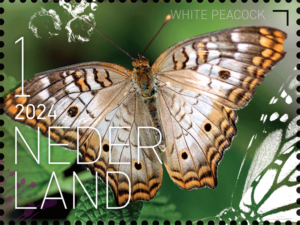 Bruna post offices and www.postnl.nl/bijzondere-postzegels. The stamps are also available for order by telephone from Collect Club’s Customer Service department on +31 (0)88 868 99 00. The validity period is indefinite.
Bruna post offices and www.postnl.nl/bijzondere-postzegels. The stamps are also available for order by telephone from Collect Club’s Customer Service department on +31 (0)88 868 99 00. The validity period is indefinite.
Technical Data:
Stamp size: 40 x 30mm:
Sheet size: 122 x 170mm
Paper: normal with phosphor print
Gumming: self adhesive
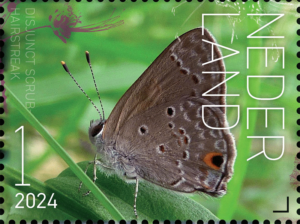 Printing technique: offset
Printing technique: offset
Print colours: cyan, magenta, yellow and black
Circulation: 285,000 sheets
Appearance: sheet of 10 stamps in 10 different designs
Design: Frank Janse, Gouda
Photography: Alamy, Dreamstime, Shutterstock and Wikimedia Commons (Anne Toal, : Charles J. Sharp, Gailhampshire, Renee from Las Vegas, Vinayaraj)
Printing house: Koninklijke Joh. Enschedé B.V., Haarlem
Item number: 440261
The Ten Species on the Stamps:
 The little yellow (Pyrisitia lisa) is a species of butterfly in the Pieridae family (whites). These native butterflies are known for their distinctive lemon-yellow colour, which makes them easy to spot. The little yellow has a wingspan of approximately 4 to 5cm and a distinctive black edge along the wings, which contrasts with their bright yellow colour. The caterpillars in this species are green with fine black dots. They usually feed on plants in the Brassicaceae family, such as mustard and cabbage.
The little yellow (Pyrisitia lisa) is a species of butterfly in the Pieridae family (whites). These native butterflies are known for their distinctive lemon-yellow colour, which makes them easy to spot. The little yellow has a wingspan of approximately 4 to 5cm and a distinctive black edge along the wings, which contrasts with their bright yellow colour. The caterpillars in this species are green with fine black dots. They usually feed on plants in the Brassicaceae family, such as mustard and cabbage.
 The hanno blue (Hemiargus hanno) is a small butterfly species in the Lycaenidae family (small pages, fireflies and blues). Found in North and South America, this butterfly is known for its vibrant orange colour, which sets it apart from many other blues. The hanno blue lives in various habitats, including open fields, meadows and gardens, where they feed on nectar from various flowers such as butterfly bushes and clover species. These butterflies have a symbiotic relationship with ants. The ants protect the caterpillars in exchange for sweet secretions.
The hanno blue (Hemiargus hanno) is a small butterfly species in the Lycaenidae family (small pages, fireflies and blues). Found in North and South America, this butterfly is known for its vibrant orange colour, which sets it apart from many other blues. The hanno blue lives in various habitats, including open fields, meadows and gardens, where they feed on nectar from various flowers such as butterfly bushes and clover species. These butterflies have a symbiotic relationship with ants. The ants protect the caterpillars in exchange for sweet secretions.
 The mimic (Hypolimnas misippus) is a conspicuous butterfly species in the Nymphalidae family (cobblers, pearl moths and sand moths). Males have a striking appearance, with deep black wings and white spots and stripes reminiscent of a diadem or crown. Females, on the other hand, have a browner colour with a light edge on their wings. What is interesting about the mimic (hence the name) is the mimetic behaviour they exhibit. They mimic the appearance of poisonous butterflies, which makes them less appealing to predators.
The mimic (Hypolimnas misippus) is a conspicuous butterfly species in the Nymphalidae family (cobblers, pearl moths and sand moths). Males have a striking appearance, with deep black wings and white spots and stripes reminiscent of a diadem or crown. Females, on the other hand, have a browner colour with a light edge on their wings. What is interesting about the mimic (hence the name) is the mimetic behaviour they exhibit. They mimic the appearance of poisonous butterflies, which makes them less appealing to predators.
 The monarch butterfly (Danaus plexippus) is one of the best-known butterfly species of North and South America. These butterflies in the Nymphalidae family (cobblers, pearl moths and sand moths) migrate northwards in large numbers in the spring, developing several generations. In the autumn, they return south, where the species overwinters in huge groups. The monarch butterfly is a fairly large butterfly: its total body length measures approximately 5cm and it has a wingspan of up to 10cm. The wings feature bold colours, and orange is the main colour. The wing surface is divided into cells by the black wing edge. The wing margin has a broad black edge with lots of small white spots.
The monarch butterfly (Danaus plexippus) is one of the best-known butterfly species of North and South America. These butterflies in the Nymphalidae family (cobblers, pearl moths and sand moths) migrate northwards in large numbers in the spring, developing several generations. In the autumn, they return south, where the species overwinters in huge groups. The monarch butterfly is a fairly large butterfly: its total body length measures approximately 5cm and it has a wingspan of up to 10cm. The wings feature bold colours, and orange is the main colour. The wing surface is divided into cells by the black wing edge. The wing margin has a broad black edge with lots of small white spots.
 The fiery skipper (Hylephila phyleus) is a species of butterfly in the Hesperiidae family (tadpoles). This butterfly is commonly found in North, Central and South America. It resides in numerous habitats, from open grasslands to gardens and verges. The fiery skipper has a wingspan of 2.5 to 3.5cm and gets its name from the vibrant orangey brown colour on its wings, which is reminiscent of flickering fire. The wings also feature distinctive black stripes and white spots. These butterflies prefer nectar-rich flowers and feed on a variety of plants. The fiery skipper has a fast, frisky flight style, as it appears to ‘skip’ from flower to flower, which is characteristic of many species in the Hesperiidae family.
The fiery skipper (Hylephila phyleus) is a species of butterfly in the Hesperiidae family (tadpoles). This butterfly is commonly found in North, Central and South America. It resides in numerous habitats, from open grasslands to gardens and verges. The fiery skipper has a wingspan of 2.5 to 3.5cm and gets its name from the vibrant orangey brown colour on its wings, which is reminiscent of flickering fire. The wings also feature distinctive black stripes and white spots. These butterflies prefer nectar-rich flowers and feed on a variety of plants. The fiery skipper has a fast, frisky flight style, as it appears to ‘skip’ from flower to flower, which is characteristic of many species in the Hesperiidae family.
 The white peacock (Anartia jatrophae) is a remarkable species of butterfly in the Nymphalidae family (cobblers, pearl moths and sand moths). Native to parts of North and South America, this butterfly is known for its refined appearance and unique wing patterns. The butterfly gets its name from the white colour of the top of its wings, with prominent eye spots and blue and black accents. The undersides of the wings have a more camouflage-like appearance, with brown and grey tones, which help the butterfly to hide against natural backgrounds while resting. They are also known for their exuberant flight style and they can be spotted in large numbers during migration.
The white peacock (Anartia jatrophae) is a remarkable species of butterfly in the Nymphalidae family (cobblers, pearl moths and sand moths). Native to parts of North and South America, this butterfly is known for its refined appearance and unique wing patterns. The butterfly gets its name from the white colour of the top of its wings, with prominent eye spots and blue and black accents. The undersides of the wings have a more camouflage-like appearance, with brown and grey tones, which help the butterfly to hide against natural backgrounds while resting. They are also known for their exuberant flight style and they can be spotted in large numbers during migration.
 The cracker (Hamadryas feronia) is a species of butterfly in the Nymphalidae family (cobblers, pearl moths and sand moths). This butterfly is known for its striking appearance and intriguing behaviour. The extraordinary thing about the cracker is its wing pattern. The top of its wings is a deep brown colour, with white stripes that make it look like a zebra, hence the nickname ‘zebra nymph butterfly’. The undersides of their wings feature a distinctive, bright red colour and an eye-spot pattern. This serves to deter predators by distracting them and making them think they are being watched by a larger animal. These butterflies are also known to sunbathe on tree trunks and their tendency to flock in large groups.
The cracker (Hamadryas feronia) is a species of butterfly in the Nymphalidae family (cobblers, pearl moths and sand moths). This butterfly is known for its striking appearance and intriguing behaviour. The extraordinary thing about the cracker is its wing pattern. The top of its wings is a deep brown colour, with white stripes that make it look like a zebra, hence the nickname ‘zebra nymph butterfly’. The undersides of their wings feature a distinctive, bright red colour and an eye-spot pattern. This serves to deter predators by distracting them and making them think they are being watched by a larger animal. These butterflies are also known to sunbathe on tree trunks and their tendency to flock in large groups.
 The disjunct scrub-hairstreak (Strymon bubastus) is a small species of butterfly in the Lycaenidae family (small pages, fireflies and blues). This butterfly can be found in open habitats such as grasslands, meadows, verges and flower fields. Its boldest feature is the two long tails that protrude from the hind wings. The top of the male’s wings is usually a bluish purple colour, while that of the female is browner with orange spots and an orange edge. This fast, active butterfly gathers nectar from a variety of flowers, including clovers and lupins. They play an important role in the pollination of these plants.
The disjunct scrub-hairstreak (Strymon bubastus) is a small species of butterfly in the Lycaenidae family (small pages, fireflies and blues). This butterfly can be found in open habitats such as grasslands, meadows, verges and flower fields. Its boldest feature is the two long tails that protrude from the hind wings. The top of the male’s wings is usually a bluish purple colour, while that of the female is browner with orange spots and an orange edge. This fast, active butterfly gathers nectar from a variety of flowers, including clovers and lupins. They play an important role in the pollination of these plants.
 The great southern white (Ascia monuste) is a remarkable butterfly species in the Pieridae family (whites). Native to parts of North and South America, these butterflies get their name from their distinctive white colour. The great southern white is a medium-sized butterfly with a wingspan measuring approximately 5 to 7cm. The male and female have similar external characteristics, with bright white wings and several black markings along the edges. This makes them stand out from other butterflies within their habitat.
The great southern white (Ascia monuste) is a remarkable butterfly species in the Pieridae family (whites). Native to parts of North and South America, these butterflies get their name from their distinctive white colour. The great southern white is a medium-sized butterfly with a wingspan measuring approximately 5 to 7cm. The male and female have similar external characteristics, with bright white wings and several black markings along the edges. This makes them stand out from other butterflies within their habitat.
 The gulf fritillary (Agraulus vanillae) is a remarkable butterfly species in the Nymphalidae family (cobblers, pearl moths and sand moths). The tops of the wings have a bright orange colour with black spots and stripes, while the undersides have a silvery sheen with prominent pearly spots. These striking colours serve as a deterrent (aposematism), that warn predators of their unpalatability. This butterfly’s caterpillars feed exclusively on passion flowers. The flowers contain toxins, but the caterpillars have adapted so that they tolerate those toxins.
The gulf fritillary (Agraulus vanillae) is a remarkable butterfly species in the Nymphalidae family (cobblers, pearl moths and sand moths). The tops of the wings have a bright orange colour with black spots and stripes, while the undersides have a silvery sheen with prominent pearly spots. These striking colours serve as a deterrent (aposematism), that warn predators of their unpalatability. This butterfly’s caterpillars feed exclusively on passion flowers. The flowers contain toxins, but the caterpillars have adapted so that they tolerate those toxins.
Sources: National Geographic, Naturalis Dutch Caribbean Species Register via PostNL.
There are two first day covers for this issue, each with 5 stamps: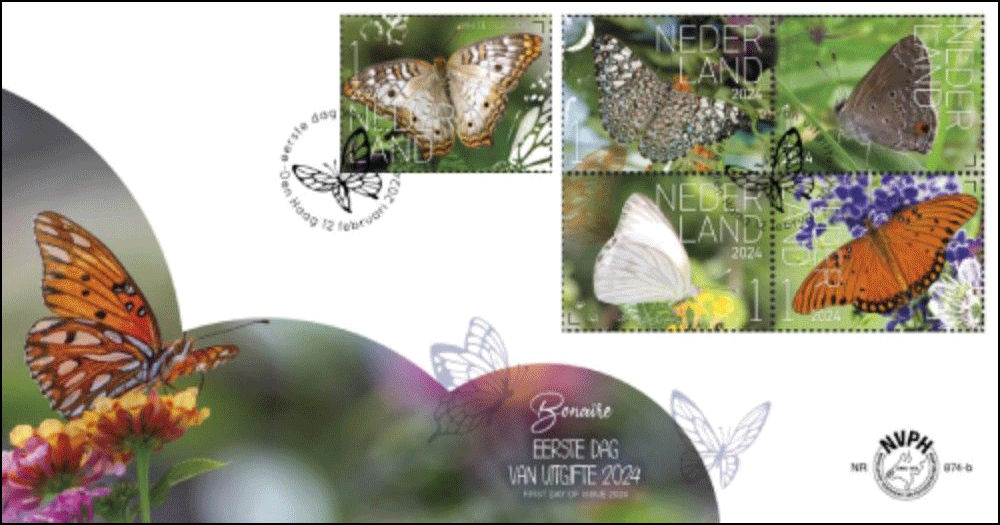
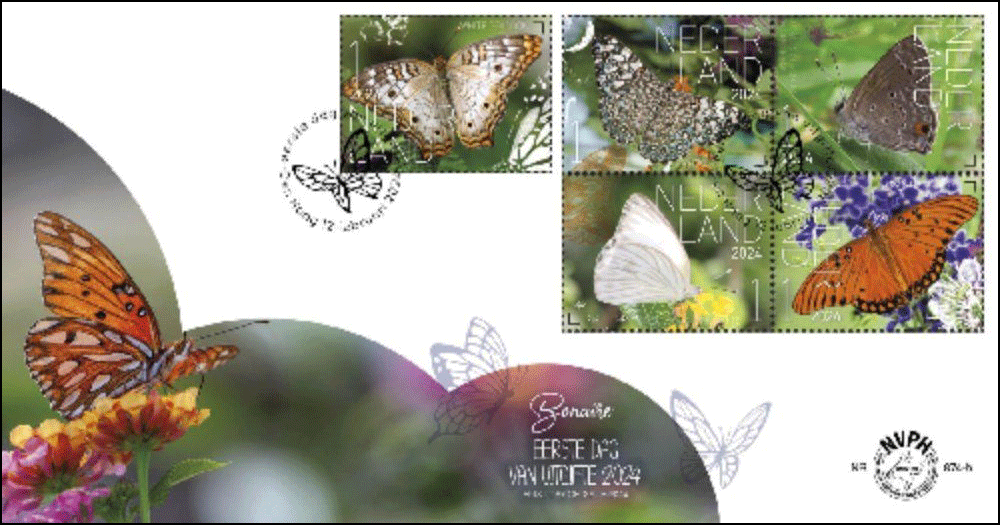
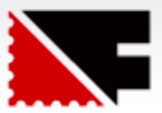 Note: PostNL does not sell directly to collectors in North America. Its website refers to a company called Nordfirm, which says it sells Dutch new issues at face value. The Virtual Stamp Club has no connection to this company.
Note: PostNL does not sell directly to collectors in North America. Its website refers to a company called Nordfirm, which says it sells Dutch new issues at face value. The Virtual Stamp Club has no connection to this company.
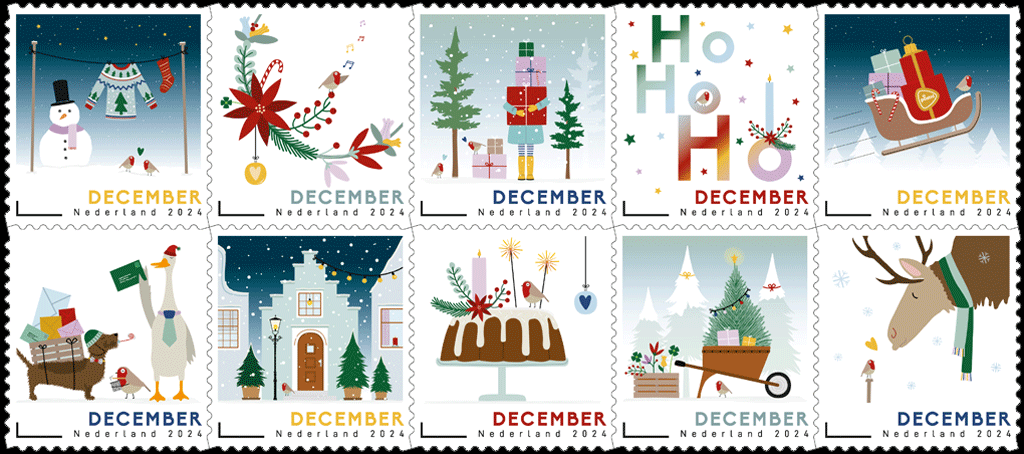 The Hague, 18 November 2024 – This year, PostNL is issuing atmospheric December stamps with robins, designed by illustrator Marieke Ruts. The ten unique scenes on the stamps convey a message of hope and warmth for the holidays. The robins, beloved birds that symbolize comfort and resilience, are incorporated into various
The Hague, 18 November 2024 – This year, PostNL is issuing atmospheric December stamps with robins, designed by illustrator Marieke Ruts. The ten unique scenes on the stamps convey a message of hope and warmth for the holidays. The robins, beloved birds that symbolize comfort and resilience, are incorporated into various  playful and wintery decors.
playful and wintery decors. November 2024 to 4 January 2025.
November 2024 to 4 January 2025. a robin drive a sleigh? Those little details bring a smile and some joy during the holidays.”
a robin drive a sleigh? Those little details bring a smile and some joy during the holidays.” tradition and humor come together.
tradition and humor come together. but the December stamps may only be used from November 18, 2024 to January 4, 2025 without adding any additional stamps. A sheet with 20 December stamps costs € 21.20 this year.
but the December stamps may only be used from November 18, 2024 to January 4, 2025 without adding any additional stamps. A sheet with 20 December stamps costs € 21.20 this year. Note: PostNL does not sell directly to collectors in North America. Its website refers to a company called Nordfirm, which says it sells Dutch new issues at face value. The Virtual Stamp Club has no connection to this company.
Note: PostNL does not sell directly to collectors in North America. Its website refers to a company called Nordfirm, which says it sells Dutch new issues at face value. The Virtual Stamp Club has no connection to this company. Collectors may also wish to contact the U.S. firm Bombay Stamps, which can also obtain first day covers upon request, with lower shipping fees. The email is sales@bombaystamps.com Again, The Virtual Stamp Club has no connection to this company.
Collectors may also wish to contact the U.S. firm Bombay Stamps, which can also obtain first day covers upon request, with lower shipping fees. The email is sales@bombaystamps.com Again, The Virtual Stamp Club has no connection to this company.
